I-MRSEC, Champaign Educator Jamie Roundtree, Embrace Hip Hop/Rap to Reach Youth at Their Level
Feburary 14, 2019
“So if you can find value and show value for what students value, then they are going to find value in the things you are asking them to value.” – Jamie Roundtree
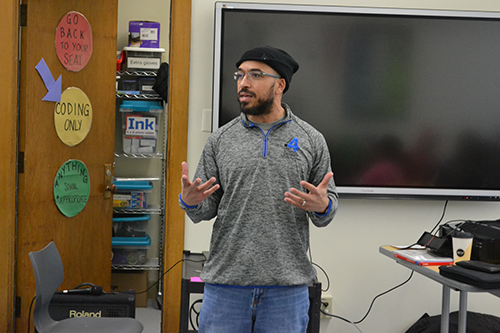
Jamie Roundtree explaining to a Franklin STEAM Academy class how they can use Hip Hop to learn.
While some folks might insist that Hip Hop or rap doesn’t belong in the classroom, some of those involved with I-MRSEC’s Musical Magnetism curriculum, including Champaign Unit 4’s Director of Elementary Teaching and Learning, Jamie Roundtree, would disagree. They’re using the medium as a way to teach the students at Franklin STEAM Academy about, and get them engaged with, science—specifically magnetism. As part of the multidisciplinary curriculum, students are creating a rap song about one of a number of principles related to magnetism.
Why Hip Hop? Roundtree says it’s something kids identify with. "Well, I think over the years, hip hop has become part of a generational culture and a value in that culture.” He adds that educators can use it to connect with the kids, explaining that, “It creates spaces where they're learning academics and builds bridges and connections.”
He claims that if educators can identify with the kids’ stuff (music, rap), the kids might identify with their stuff (academics, learning about science).
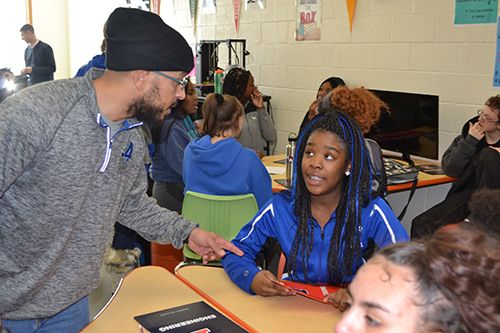
Jamie Roundtree speaking with a student while they brainstorm about what words come to mind about STEAM.
“So if you can find value and show value for what students value, then they are going to find value in the things you are asking them to value,” Roundtree explains, regarding the reciprocal nature of using hip hop to connect with students. “If you can build those connections and those bridges,” he adds, “it makes it even more powerful for them because then they see themselves in the work versus just seeing the work for the work, if that makes sense.”
In fact, Roundtree was the perfect person to visit the school to help segue into the creating rap part of the curriculum—he himself was a hip hop artist when he was younger. So he shared with the middle school students some tips about what used to get his creative juices flowing back when he would write raps.
The first hint he gave was to brainstorm. So he had the students do just that, coming up with words that came to mind when considering the word STEAM. The second concept he shared was bridges. To illustrate how the concept works, he had students come up with ideas related to one of the words that came out of the STEAM brainstorming session: science. Then he demonstrated how to build a bridge from the word science to create another list of related words, then take those words and create phrases. Finally, he demonstrated how to create a rap using those phrases as the structure and adding in filler words by doing an adhoc rap about science…from start to finish, the process took about 10 to 15 minutes.
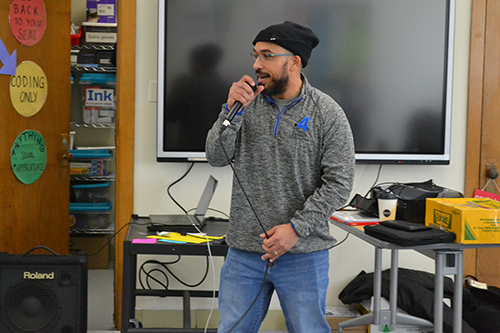
Jamie Roundtree rapping for students at Franklin STEAM Academy..
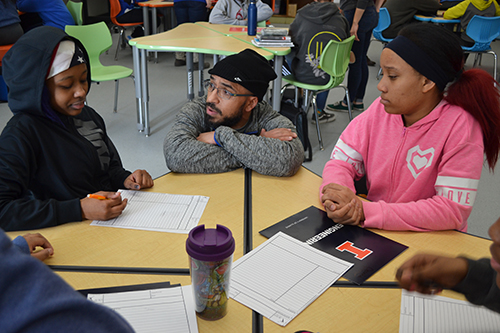
Jamie Roundtree speaking with students while they brainstorm about what words come to mind about STEAM.
Then, as a treat for both the students and the adults, near the end of the class period, he did another little performance to give the kids an idea of the kind of stuff he used to do.
So how did a rapper in the hip hop scene end up becoming an educator? Roundtree reached a point in his career when he was struggling to pay the bills, so he took a short break and went back to school, where he discovered something he was even more passionate about than rap—teaching.
“I just found a new passion for teaching and working with the kids. It's just a different level, and there's a different challenge there. Um, and it's a need, y'know?”
He goes on to share one of the reasons that he gives people for why he became an educator. He recalls that after 12 years of education in public school, he could only remember a couple teachers. “And I don't remember having a connection with them. I just remember them because they had strange names, like Mr. Mister. Do you know what I'm sayin'? But that's sad for me.”
Thus, Roundtree’s goal in becoming a teacher was so that a few of today’s kids might have some specific, memorable experiences when they look back on their childhood: “So I wanted kids, like when I was a teacher, to remember at least their experience. If they don't remember the names and the content, they just remember the feeling. Like: "Ah, the fifth grade was fun. I can't remember what it was, but..." Or they remember, "Mr. Roundtree was a blast, and we learned da da da.”
That’s one reason that Roundtree, now a program director at the district level for the last ten years or so, got involved with the Musical Magnetism curriculum. He wants kids to say, “Remember that project we did with this?!”
“That's what I want the kids to walk away with. And so, if they don't remember anything from whatever grade this is, they say, "Remember that old guy who came and rapped for us that one time? He had us sayin': ‘What it is, what it do!’ And he was tryin’... y'know?’” He wants them to at least remember that the experience was fun and rewarding.
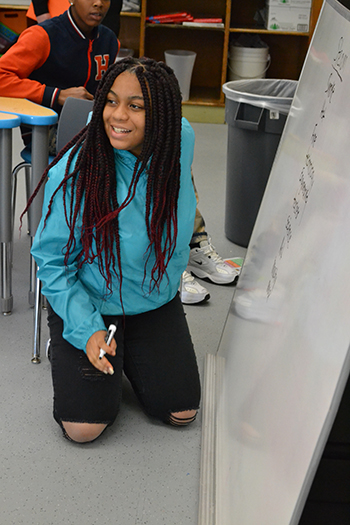
A Franklin student writes the classes ideas for words that describe STEAM on a whiteboard.
He’s also particularly hopeful that they might take away some of the meat of his presentation—like how they can brainstorm ideas and then build connections. He reports that those concepts are not just for writing rhymes, but “That's for problem solving, engineering. Right? It's just for them to understand problem solving and processes, whether you're talking about computational thinking, computer science, engineering, art.”
He’s also hopeful that through this curriculum, that he and the others involved with the project can teach the students how to take the different strategies they’re applying to things they’re interested in personally, such as creating hip hop, then hopefully carry them over into other aspects of their lives. “They're here to learn skills and strategies for problem solving in life and working towards goals,” he insists.
Roundtree stresses that this is what he’s found to be true in his own life. “Cause…the skills and abilities and talents that I learned being an MC, a performer, a writer, have transcended into my role as an educator and administrator.”
Roundtree explains how he ended up being involved with the Musical Magnetism curriculum in the first place. He went to graduate school with several of Franklin’s teachers, and they’d remembered how much they had gotten out of a rap he had created for one of the class assignments, and the impact it had had on them. So when they were brainstorming about using rap to teach science, he immediately came to mind.
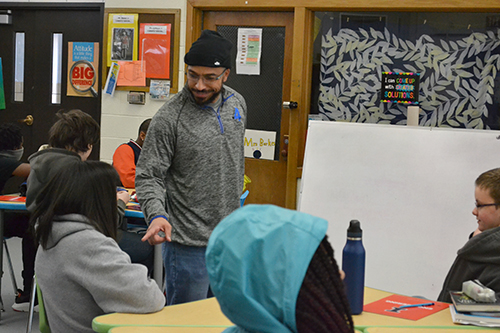
Jamie Roundtree speaking with students about how Hip Hop can help them learn.
Referring to the bridge concept he presented to the kids earlier, Roundtree explains that once he had made that connection in grad school and was able to use his hip hop talents to write and communicate, then he was able to translate those to a classroom and a profession.
“Kids don't recognize that the talents you develop now will play out in ways that you never knew,” he claims, sharing that that was really the point of his story. “I started out thinkin' I was gonna be the next NBA (Never Broke Again) YoungBoy or whatever, and that was my dream!”
Through the Musical Magnetism curriculum, Roundtree is hopeful that, as was the case in his life, the kids will discover things within that they never really expected, and develop talents that they can’t imagine where they might take them. “So for them again, it's all about those connections, and that's what I love most about this.”
Story and photos by Elizabeth Innes, Communications Specialist, I-STEM Education Initiative.
More: 6-8 Outreach, I-MRSEC, 2019













.jpg)
















